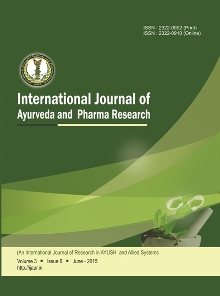Effect of Panchakarma Therapy in the Management of Spinocerebellar Ataxia
Abstract
Spino cerebellar ataxia is a progressive cerebellar ataxia inherited by autosomal dominant transmission, it occurs as a result of derangement of cerebellum and its afferent and efferent pathways. Signs and symptoms of ataxia includes gait impairment, scanning speech, blurred vision due to nystagmus, incoordination of hand and tremor with movement. The present case involves a patient diagnosed as spino cerebellar ataxia which was successfully managed with ayurvedic treatment. A 36 year old female patient having complaints of imbalance, slurred speech, poor coordination with tremors diagnosed as Vatavyadhi due to Avarana. The treatment was based on the principles of Kaphahara and Marutha anulomana. Treatment adopted was Swedana, Udwartana, Virechana, Utsadana, Balaguduchyadhi vasti, Navadhanya kizhi, Nasya and Shirovasti. Assessment of the patient was done using SARA scale before and after the treatment.
Copyright (c) 2025 International Journal of Ayurveda and Pharma Research

This work is licensed under a Creative Commons Attribution-NonCommercial-ShareAlike 4.0 International License.


